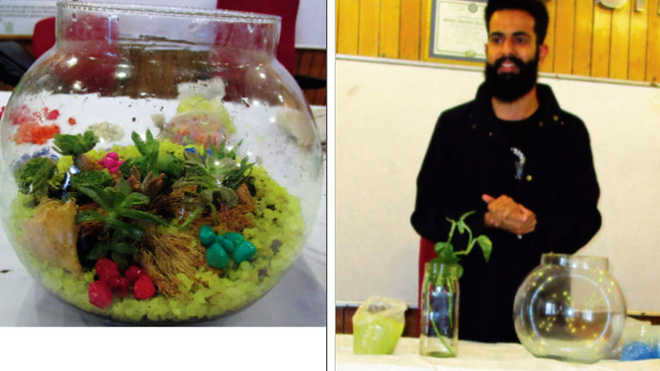Eco-system in a bottle
Shriniwas Joshi
SHIMLA has a small Rotary Bhawan on The Mall. People like it for its location and, courtesy Rotary; hire it on nominal rent for holding their meetings or functions.
The hall is small and can hardly accommodate 100 people, but serves the purpose well. I wish that one such hall be earmarked in the rejuvenated Town Hall, which is still not allotted to any department or organisation though its inauguration was done by the Chief Minister long ago. There is one conference hall in the Gaiety complex, but the Language and Culture Department has fixed its hire charges so exorbitant that NGOs can ill-afford it. The Rotary Bhawan has a bust of Paul Harris, who was a lawyer at Chicago in 1896. He organised the first Rotary Club ‘in fellowship and friendship’ in 1905 and that made him popular.
Shimla Amateur Garden and Environment Society (SAGES) hired the hall for a workshop on how to develop Terrarium and Hydroponic. Hydroponic is the process of growing plants in sand, gravel or liquid without soil, but I will dwell on terrarium here. Siddharth Banerjee, an alumnus of Hindu College, Delhi and Forest Research Institute, Dehradun, who had done the work on these earlier, accepted to deliver the lec-dem. A terrarium, bottle-garden or Wardian cases are all essentially the same thing and in that each contains and supports a miniature ecosystem of plants. Historically, these were used to transport plants from their native countries to other countries, where ordinarily their survival is difficult due to altered conditions. The name Wardian has come from a Londoner-an explorer, a botanist, an inventor – Nathaniel Bagshaw Ward. A doctor by trade, he changed the world with his botanical glass container of plants and called them Wardian cases.
Today, when people in towns are living in apartments where there is little or no outdoor space, terrarium functions as a substitute garden. These are also developed in schools to study miniature ecosystem. A lady who runs a school in Shimla evinced keen interest in the proceedings, so that she could introduce it in her school. SAGES president RL Jain said they would initiate the organisation of such lec-dems in different schools of Shimla.
In the given lec-dem, the vessel used for terrarium was brand new, but a used bottle or vessel could be used for it. The container needs to be washed absolutely clean. Siddharth went on cleaning even the new container and said a dusty outside would reduce the amount of light that reached inside. He said a dirty interior, too, would do the same besides encouraging disease. I add that because it is going to be the focal point in the home drawing attention of visitors, so it requires being clean and attractive.
When the vessel is absolutely clean, the first layer of gravel or marble chips touching the wall of the container is laid. The second layer is that of wood shearing. Third is of charcoal, which reduces any smell caused by decomposition within the vessel. Siddharth said to please the eyes of the beholder, coloured sand particles or brick powder may be used to touch the walls of the vessel, but the soil compost has to be in the middle, on which the plants are grown. Siddharth said the slow growth plants were preferred in the terrarium and the flower producing houseplants might be discounted because flowers did not tend to do well in moisture rich atmosphere. One’s creativity comes to fore when developing a terrarium. How to make it attractive by using a becoming colour scheme for the walls of the terrarium? What plants are to be used? The vessel used for lec-dem was open-mouthed and the hands of Siddharth could dip inside to grow plants, but if the vessel is narrow, then a long handled spoon or chopstick has to be used. The final thing to do is watering the plants. It has to be sprinkled and not watered as one does in houseplants. On the day of lec-dem, the lid or a stopper was not there, but with a lid, it could be a closed bottle garden and might never need watering again. An open bottle garden, however, required a small sprinkling of water every couple of months. So, this type of gardens do much saving on water and are perfect for places where there is shortage of water.
A terrarium is the smallest surviving ecosystem in the world. A garden in a bottle, planted by David Latimer in 1960 was last watered in 1972 before it was tightly sealed. This little world is still thriving entirely on recycled air, nutrients and water formed inside the terrarium. The only external thing fed to this bottle-garden was light without which there would be no energy for plants inside to create their own food and continue to grow. A terrarium is an entirely self-sufficient ecosystem..
TAILPIECE
He that grows plants, either in terrarium or in pots, loves others besides himself










